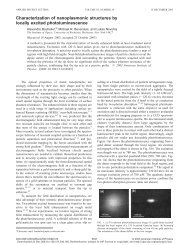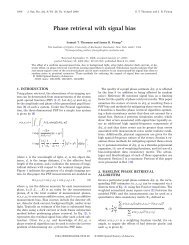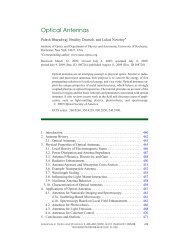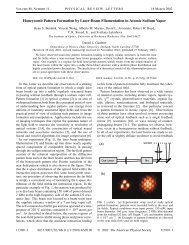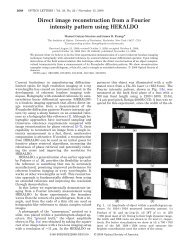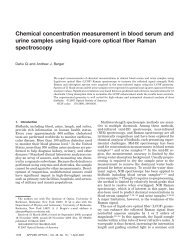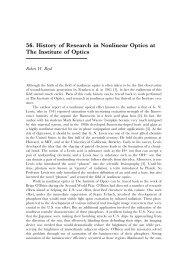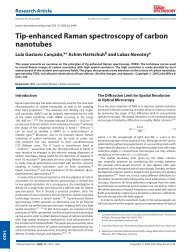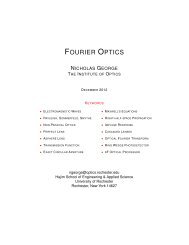Applied Optics Letters to the Editor - The Institute of Optics
Applied Optics Letters to the Editor - The Institute of Optics
Applied Optics Letters to the Editor - The Institute of Optics
Create successful ePaper yourself
Turn your PDF publications into a flip-book with our unique Google optimized e-Paper software.
<strong>Applied</strong><br />
<strong>Optics</strong><br />
Multiemulsion On-Axis Computer Generated<br />
Hologram<br />
D. C. Chu, J. R. Fienup, and J. W. Goodman<br />
Department <strong>of</strong> Electrical Engineering, Stanford University,<br />
Stanford, California 94035.<br />
Received 23 February 1973.<br />
A key problem in computer holography is <strong>the</strong> realization<br />
<strong>of</strong> a transparency that controls both <strong>the</strong> amplitude<br />
and phase <strong>of</strong> a transmitted wave at each point in accord<br />
with a computed complex function. <strong>The</strong>re are many approaches<br />
<strong>to</strong> simultaneous amplitude and phase control,<br />
including sandwiching <strong>of</strong> two independent transmitting<br />
structures, 1 - 2 <strong>the</strong> use <strong>of</strong> quadrature holograms, 3 carrier<br />
frequency holograms, 4 de<strong>to</strong>ur phase holograms, 5 and related<br />
methods. 6-8 Sandwich transparencies are generally<br />
difficult <strong>to</strong> align properly, and quadrature holograms must<br />
be reconstructed in a precision interferometric arrangement.<br />
Carrier frequency holograms and de<strong>to</strong>ur phase holograms<br />
reconstruct twin images; as a consequence, <strong>the</strong>y<br />
are both wasteful <strong>of</strong> resolution, and in computer-generated<br />
form are low in realizable diffraction efficiency. Kin<strong>of</strong>orms<br />
9 make better use <strong>of</strong> available resolution and can be<br />
highly efficient, but suffer a degree <strong>of</strong> background noise<br />
due <strong>to</strong> <strong>the</strong> discarding <strong>of</strong> amplitude information.<br />
We wish <strong>to</strong> report on a new type <strong>of</strong> computer generated<br />
hologram that retains <strong>the</strong> advantages <strong>of</strong> a kin<strong>of</strong>orm but<br />
provides effective control over both amplitude and phase<br />
transmittance. By means <strong>of</strong> multiemulsion color film, a<br />
sandwich filter is recorded with no need for later alignment.<br />
An added benefit <strong>of</strong> this approach is that <strong>the</strong> film<br />
can be purchased and processed through any drug s<strong>to</strong>re;<br />
<strong>the</strong> experimen<strong>to</strong>r need not have personal access <strong>to</strong> any<br />
film processing facility.<br />
<strong>The</strong> basic principle we have used can be explained as<br />
follows. Color reversal films contain several emulsion<br />
layers, each ideally sensitive <strong>to</strong> light in a different region<br />
<strong>of</strong> <strong>the</strong> visible spectrum. Our particular experiments have<br />
used Kodachrome II, which has three layers sensitive individually<br />
<strong>to</strong> blue, green, and red light. <strong>The</strong>se emulsions<br />
give rise <strong>to</strong> dye images that are predominantly blue absorbing<br />
(yellow), green absorbing (magenta), and red absorbing<br />
(cyan), respectively. If a developed transparency<br />
is illuminated by monochromatic light, such light will be<br />
attenuated predominantly by just one <strong>of</strong> <strong>the</strong> three emulsions.<br />
<strong>The</strong> o<strong>the</strong>r two emulsions, while not attenuating<br />
<strong>the</strong> light, do exert an influence on <strong>the</strong> phase <strong>of</strong> <strong>the</strong> transmitted<br />
light, presumably through both relief and index<br />
changes (preliminary experiments indicate that both effects<br />
play a role). Thus with a judicious pair <strong>of</strong> exposures<br />
<strong>to</strong> <strong>the</strong> color film, and illumination <strong>of</strong> <strong>the</strong> processed film<br />
with monochromatic light, both <strong>the</strong> amplitude and <strong>the</strong><br />
phase <strong>of</strong> <strong>the</strong> transmitted light are controlled.<br />
In our own experiments, we began with a matrix representation<br />
<strong>of</strong> <strong>the</strong>.image we wished <strong>to</strong> obtain from our<br />
computer-generated hologram, in this case an array <strong>of</strong> binary<br />
ones and zeros in <strong>the</strong> form <strong>of</strong> <strong>the</strong> letters A, B, C, and<br />
1386 APPLIED OPTICS / Vol. 12, No. 7 / July 1973<br />
<strong>Letters</strong> <strong>to</strong> <strong>the</strong> Edi<strong>to</strong>r<br />
<strong>Letters</strong> <strong>to</strong> <strong>the</strong> Edi<strong>to</strong>rs should be addressed <strong>to</strong> <strong>the</strong> Edi<strong>to</strong>r, APPLIED OPTICS, AFCRL,<br />
Bedford, Mass. 01730. If authors will state in <strong>the</strong>ir covering communication whe<strong>the</strong>r<br />
<strong>the</strong>y expect <strong>the</strong>ir institutions <strong>to</strong> pay <strong>the</strong> publication charge, publication time should be<br />
shortened (for those who do).<br />
D. <strong>The</strong>se characters were imbedded in a field <strong>of</strong> 32 × 32<br />
elements. Phase coding was applied <strong>to</strong> <strong>the</strong>se elements <strong>to</strong><br />
lower <strong>the</strong> dynamic range <strong>of</strong> <strong>the</strong> spectrum; each data value<br />
ƒnq was multiplied by exp(i2πnq/N'), where N' is <strong>the</strong> actual<br />
size <strong>of</strong> <strong>the</strong> data block embedded in <strong>the</strong> 32 × 32 array.<br />
<strong>The</strong> phase coded array was <strong>the</strong>n Fourier transformed<br />
using a two-dimensional FFT program <strong>to</strong> produce a 32 ×<br />
32 array <strong>of</strong> complex Fourier coefficients,<br />
Separating amplitude and phase information, we have two<br />
32 × 32 matrices, one with elements Amp and <strong>the</strong> second<br />
with elements θmp, which always lies between 0 and 2π.<br />
<strong>The</strong>se two matrices are displayed sequentially on a<br />
CRT and pho<strong>to</strong>graphed using different color filters. <strong>The</strong><br />
basic 32 × 32 patterns are replicated 4×4 times, and<br />
each Fourier coefficient is displayed with a 2 × 2 grid <strong>of</strong><br />
spots. Hence <strong>the</strong>re are 256 × 256 spots displayed by <strong>the</strong><br />
CRT for each exposure. <strong>The</strong> exposure contributed by<br />
each CRT spot is controlled by <strong>the</strong> time duration that <strong>the</strong><br />
electron beam spends on that spot, generating gray levels<br />
that are for all practical purposes continuous. <strong>The</strong> displayed<br />
patterns are pho<strong>to</strong>graphed using a 35-mm single<br />
lens reflex camera with a 55-mm lens, mounted 80 cm<br />
from <strong>the</strong> CRT face and shielded by a cardboard tube.<br />
Exposures are made on regions <strong>of</strong> <strong>the</strong> film characteristic<br />
where <strong>the</strong> densities <strong>to</strong> red and cyan light are approximately<br />
linearly related <strong>to</strong> <strong>the</strong> logarithms <strong>of</strong> <strong>the</strong> red and<br />
cyan exposures, respectively. For exposures <strong>of</strong> <strong>the</strong> amplitude<br />
information, <strong>the</strong> entire linear dynamic range <strong>of</strong> <strong>the</strong><br />
Fig. 1. Magnified pho<strong>to</strong>graph <strong>of</strong> a hologram.
ed-absorbing emulsion is used; <strong>the</strong> red exposures are<br />
made such that <strong>the</strong> final amplitude transmittance <strong>to</strong> red<br />
light is proportional <strong>to</strong> <strong>the</strong> desired amplitude.<br />
For exposing <strong>the</strong> emulsions that control phase, we again<br />
operate on <strong>the</strong> linear portion <strong>of</strong> <strong>the</strong> H & D curve, where<br />
<strong>the</strong> density <strong>to</strong> cyan light is linearly proportional <strong>to</strong> <strong>the</strong> log<br />
<strong>of</strong> cyan exposure. Here we adopt <strong>the</strong> assumption, <strong>of</strong>ten<br />
used in <strong>the</strong> past, <strong>the</strong> phase shift is proportional <strong>to</strong> density.<br />
10 " 12 In addition, by separate experiments in which<br />
saw<strong>to</strong>oth patterns are displayed and pho<strong>to</strong>graphed, it is<br />
possible <strong>to</strong> determine <strong>the</strong> exposure excursions necessary <strong>to</strong><br />
achieve phase matching over <strong>the</strong> 0 <strong>to</strong> 2π range. In our<br />
experiments <strong>the</strong>se excursions were found <strong>to</strong> lie well within<br />
<strong>the</strong> linear region <strong>of</strong> <strong>the</strong> H & D curve.<br />
It should be noted that <strong>the</strong> red-absorbing emulsion will<br />
also suffer relief and index changes, and as a consequence<br />
some unwanted phase changes may be introduced. We<br />
have compensated for this affect by lessening <strong>the</strong> log <strong>of</strong><br />
<strong>the</strong> cyan exposure by an amount proportional <strong>to</strong> <strong>the</strong> log <strong>of</strong><br />
<strong>the</strong> red exposure, <strong>the</strong> proportionality constant being determined<br />
experimentally.<br />
In our experiments, <strong>the</strong> first displayed pattern, representing<br />
amplitude information, was pho<strong>to</strong>graphed through<br />
a Kodak Wratten 26 red filter. <strong>The</strong> second displayed pattern,<br />
representing phase information, was pho<strong>to</strong>graphed<br />
through a cyan filter. Care is taken <strong>to</strong> avoid moving <strong>the</strong><br />
camera between exposures and <strong>the</strong>reby destroying registration.<br />
<strong>The</strong> exposed film is sent <strong>to</strong> a local Kodak processing<br />
labora<strong>to</strong>ry. Finally, <strong>the</strong> processed transparency is<br />
illuminated by 6328-Å light from a He-Ne laser. <strong>The</strong> red<br />
light is attenuated by <strong>the</strong> red absorbing emulsion and<br />
phase shifted by <strong>the</strong> blue- and green-absorbing emulsions.<br />
<strong>The</strong> desired image is obtained in <strong>the</strong> focal plane <strong>of</strong> a positive<br />
lens, where it appears centered about <strong>the</strong> optical axis.<br />
Experimental results obtained using <strong>the</strong> above procedure<br />
have been excellent. Figure 1 shows a magnified<br />
picture <strong>of</strong> a hologram. Figure 2 shows an (unre<strong>to</strong>uched)<br />
Polaroid pho<strong>to</strong>graph <strong>of</strong> <strong>the</strong> reconstructed image.<br />
Since a kin<strong>of</strong>orm is simply a special case <strong>of</strong> <strong>the</strong> above<br />
hologram with all amplitude information set equal <strong>to</strong> a<br />
constant value, it is possible <strong>to</strong> make kin<strong>of</strong>orms by <strong>the</strong><br />
above procedure. In this case, <strong>to</strong> save computer time, we<br />
expose only <strong>the</strong> phase information under computer control<br />
through a cyan filter. <strong>The</strong> film is later reexposed <strong>to</strong> a flat<br />
white object through a red filter. With <strong>the</strong> use <strong>of</strong> black<br />
tape <strong>to</strong> block those regions <strong>of</strong> <strong>the</strong> transparency that lie<br />
outside <strong>the</strong> region <strong>of</strong> phase exposure, an excellent kin<strong>of</strong>orm<br />
results, in fact <strong>the</strong> best kin<strong>of</strong>orm we have been able<br />
<strong>to</strong> make by any method. Figure 3 shows a Polaroid pho<strong>to</strong>graph<br />
<strong>of</strong> <strong>the</strong> image produced by such a kin<strong>of</strong>orm. Comparing<br />
Figs. 2 and 3, <strong>the</strong> nonuniform intensities <strong>of</strong> <strong>the</strong><br />
image dots in Fig. 3 are probably due <strong>to</strong> <strong>the</strong> fact that <strong>the</strong><br />
kin<strong>of</strong>orm has discarded amplitude information.<br />
Returning <strong>to</strong> <strong>the</strong> general case, <strong>the</strong>re are several sources<br />
<strong>of</strong> error for which we have not yet attempted <strong>to</strong> compensate.<br />
First, <strong>the</strong>re is exposure cross talk between emulsions;<br />
i.e., <strong>the</strong> blue- and green-sensitive layers are also<br />
slightly exposed by red light and vice versa. Second, in<br />
addition <strong>to</strong> <strong>the</strong> red-absorbing emulsion affecting <strong>the</strong> phase<br />
transmission, <strong>the</strong> green absorbing emulsion is partially<br />
absorbing in <strong>the</strong> red (dye cross talk). Third, <strong>the</strong> relief<br />
image depends on spatial frequency (but this dependence<br />
is much less pronounced than that <strong>of</strong> <strong>the</strong> relief image in<br />
bleached Kodak 649-F). However, even without compensating<br />
for <strong>the</strong>se errors, surprisingly good results were obtained.<br />
To summarize, multiemulsion films (e.g., Kodachrome<br />
II) can be used <strong>to</strong> control directly amplitude and phase for<br />
Fig. 2. Image reconstructed from <strong>the</strong> hologram (amplitude and<br />
phase controlled).<br />
Fig. 3. Image reconstructed from a kin<strong>of</strong>orm (only phase controlled).<br />
holograms and complex spatial filters. <strong>The</strong>se transparencies<br />
are similar <strong>to</strong> sandwich type holograms, but <strong>the</strong> alignment<br />
problem is reduced <strong>to</strong> <strong>the</strong> display's ability <strong>to</strong> reposition<br />
its address accurately. <strong>The</strong> sensitivity <strong>of</strong> ordinary<br />
color films is extremely high relative <strong>to</strong> that <strong>of</strong> holographic<br />
plates, and direct exposure from a CRT is possible. 13<br />
<strong>The</strong> most restrictive limitation <strong>of</strong> such films is <strong>the</strong>ir low<br />
resolution; for example, <strong>the</strong> frequency response <strong>of</strong> Kodachrome<br />
II extends out <strong>to</strong> <strong>the</strong> range 96-135 lp/mm. 14<br />
Thus color films would be <strong>of</strong> little use for high-density<br />
optical memories. However, due <strong>to</strong> limitations <strong>of</strong> expense<br />
and display capability, computer-generated holograms<br />
seldom contain more than 1024 X 1024 Fourier coefficients,<br />
and such holograms can be easily recorded on a<br />
35 -mm color transparency, particularly since no high frequency<br />
carrier is required. A great advantage <strong>of</strong> color<br />
film is its availability and <strong>the</strong> high degree <strong>of</strong> accuracy and<br />
repeatibility associated with commercial processing. We<br />
have affectionately given this new hologram device a<br />
name: Referenceless On-Axis Complex Hologram, or<br />
ROACH. We believe this will be a very useful device for<br />
those interested in computer generated holograms.<br />
We are grateful <strong>to</strong> A. A. Sawchuk whose courtesy and<br />
assistance enabled us <strong>to</strong> make kin<strong>of</strong>orms at <strong>the</strong> University<br />
<strong>of</strong> Sou<strong>the</strong>rn California facilities at one time when we were<br />
experiencing difficulties with our own equipment.<br />
July 1973 / Vol. 12, No. 7 / APPLIED OPTICS 1387
Portions <strong>of</strong> this work were supported by <strong>the</strong> National<br />
Science Foundation, by <strong>the</strong> Hewlett-Packard Company,<br />
and by <strong>the</strong> Stanford Joint Services Electronics Program.<br />
D. Chu is also with <strong>the</strong> Hewlett-Packard Company,<br />
Santa Clara, California 95050.<br />
References<br />
1. J. Tsujiuchi, in Progress in <strong>Optics</strong>, E. Welf, Ed. (North Holland,<br />
Amsterdam, 1963), Vol. 2, pp. 131-180.<br />
2. T. M. Holladay and J. D. Gallatin, J. Opt. Soc. Am. 56, 879<br />
(1966).<br />
3. D. Gabor and W. P. Goss, J. Opt. Soc. Am. 56, 849 (1966).<br />
4. E. N. Leith and J. Upatnieks, J. Opt. Soc. Am. 52, 1123<br />
(1962).<br />
5. B. R. Brown and A. W. Lohmann, Appl. Opt. 5, 967 (1966).<br />
6. W. H. Lee, Appl. Opt. 9, 639 (1970).<br />
7. C. B. Burckhardt, Appl. Opt. 9, 1949 (1970).<br />
8. R. E. Haskell and B. C. Culver, Appl. Opt. 11, 2712 (1972).<br />
9. L. B. Lesem, P. Hirsch, and J. A. Jordan, Jr., IBM J. Res.<br />
Dev. 13, 150 (1969).<br />
10. H. M. Smith, J. Opt. Soc. Am. 58, 533 (1968).<br />
11. H. M. Smith, J. Opt. Soc. Am. 59, 1492 (1969).<br />
12. R. L. Lambert, Appl. Opt. 11, 33 (1972).<br />
13. <strong>The</strong> hologram could in principle be generated without <strong>the</strong> use<br />
<strong>of</strong> a computer or a CRT, simply by pho<strong>to</strong>graphing, with appropriate<br />
color filter, two patterns made by o<strong>the</strong>r means.<br />
14. Kodak Films for <strong>the</strong> Amateur, Kodak Pho<strong>to</strong> Information<br />
Book AF-1, D-5 (Eastman Kodak Co., Rochester, N.Y., 1971).<br />
1388 APPLIED OPTICS / Vol. 12, No. 7 / July 1973



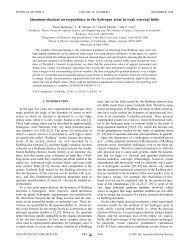
![Phase retrieval algorithms: a personal tour [Invited] - The Institute of ...](https://img.yumpu.com/25023725/1/190x249/phase-retrieval-algorithms-a-personal-tour-invited-the-institute-of-.jpg?quality=85)
